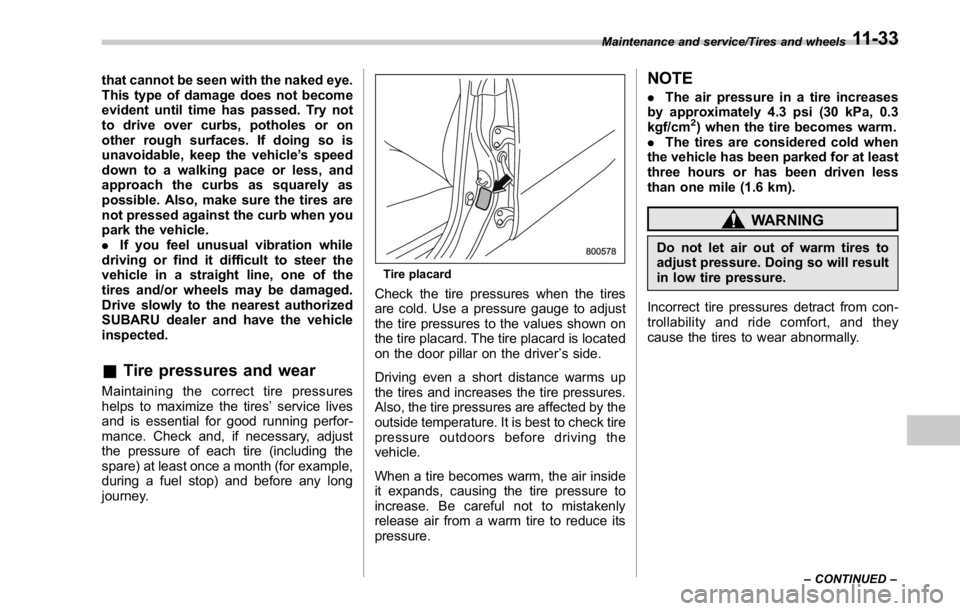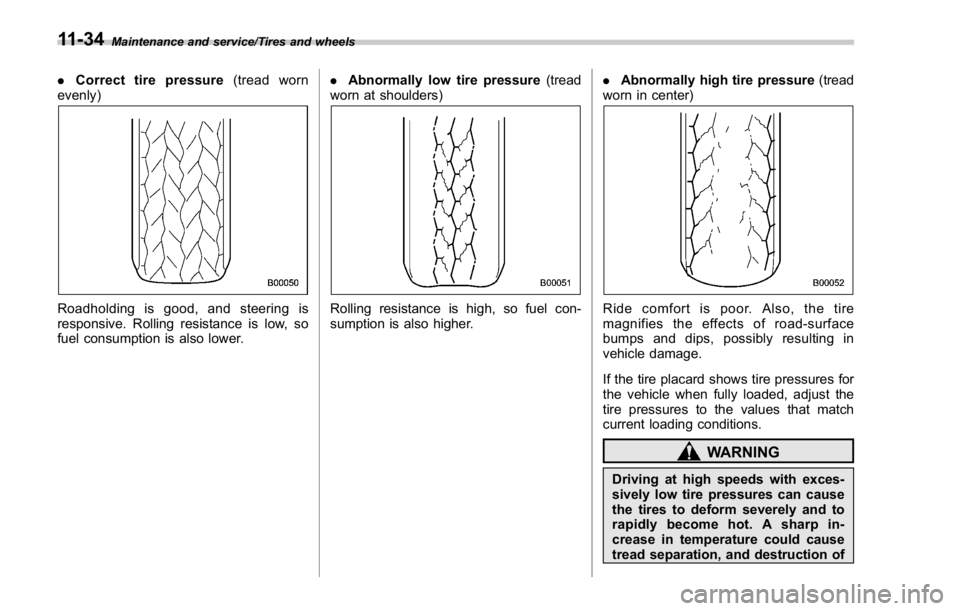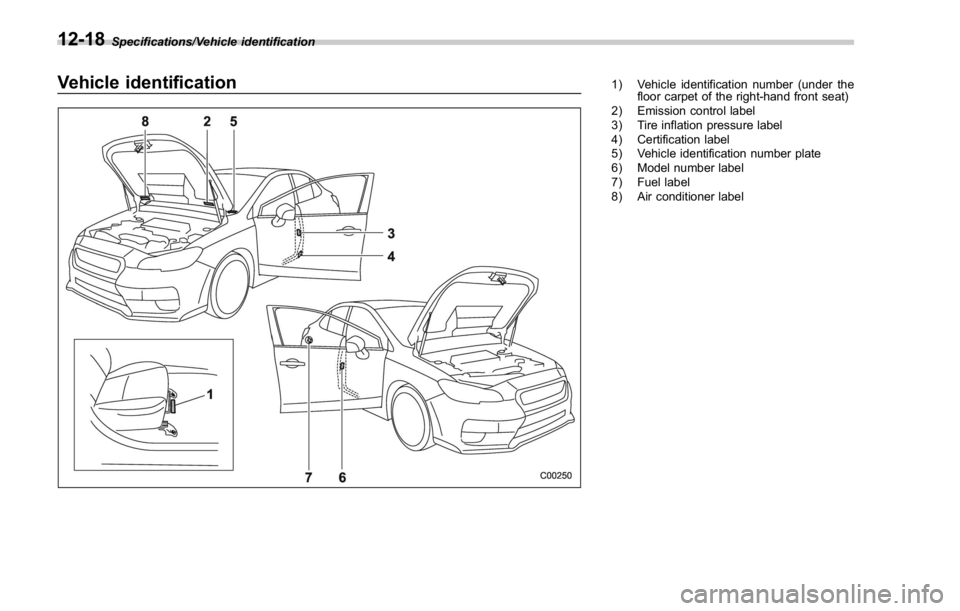2016 SUBARU WRX fuel pressure
[x] Cancel search: fuel pressurePage 455 of 594

Driving tips/New vehicle break – in driving – the first 1,000 miles (1,600 km)
New vehicle break-in driving
– the first 1,000 miles (1,600
km) The performance and long life of your
vehicle are dependent on how you handle
and care for your vehicle while it is new.
Follow these instructions during the first
1,000 miles (1,600 km):
. Do not race the engine. And do not
allow engine speed to exceed 4,000 rpm
except in an emergency.
. Do not drive at one constant engine or
vehicle speed for a long time, either fast or
slow.
. Avoid starting suddenly and rapid
acceleration, except in an emergency.
. Avoid hard braking, except in an
emergency.
The same break-in procedures should be
applied to an overhauled engine, newly
mounted engine or when brake pads or
brake linings are replaced with new ones. Fuel economy hints The following suggestions will help to save
fuel.
. Select the proper gear position for the
speed and road conditions.
. Avoid sudden acceleration or decelera-
tion. Always accelerate gently until you
reach the desired speed. Then try to
maintain that speed for as long as
possible.
. Do not pump the accelerator and avoid
racing the engine.
. Avoid unnecessary engine idling.
. Keep the engine properly tuned.
. Keep the tires inflated to the correct
pressure shown on the tire placard, which
is located under the door latch on the
driver ’ s side. Low pressure will increase
tire wear and fuel consumption.
. Use the air conditioner only when
necessary.
. Keep the front and rear wheels in
proper alignment.
. Avoid carrying unnecessary luggage or
cargo.
. The indication of the ECO gauge
shows a reference for saving fuel. For
details, refer to “ ECO gauge ” F 3-12.Engine exhaust gas (carbon
monoxide) WARNING. Never inhale engine exhaust gas.
Engine exhaust gas contains
carbon monoxide, a colorless
and odorless gas which is dan-
gerous, or even lethal, if inhaled.
. Always properly maintain the en-
gine exhaust system to prevent
engine exhaust gas from enter-
ing the vehicle.
. Never run the engine in a closed
space, such as a garage, except
for the brief time needed to drive
the vehicle in or out of it.
. Avoid remaining in a parked
vehicle for a lengthy time while
the engine is running. If that is
unavoidable, then use the venti-
lation fan to force fresh air into
the vehicle.
. Always keep the front ventilator
inlet grille free from snow, leaves
or other obstructions to ensure
that the ventilation system al-
ways works properly.
. If at any time you suspect that8-2
Page 492 of 594

Maintenance schedule The scheduled maintenance items re-
quired to be serviced at regular intervals
are shown in the “ Warranty and Main-
tenance Booklet ” .
For details of your maintenance schedule,
read the separate “ Warranty and Main-
tenance Booklet ” .
NOTE For models with a multi function dis-
play, you can set a reminder to be
displayed when a scheduled mainte-
nance item is almost due. For details,
refer to “ Maintenance settings ” F 3-79.Maintenance precautions When maintenance and service are re-
quired, it is recommended that all work be
done by an authorized SUBARU dealer.
If you perform maintenance and service
by yourself, you should familiarize yourself
with the information provided in this
section on general maintenance and
service for your SUBARU.
Incorrect or incomplete service could
cause improper or unsafe vehicle opera-
tion. Any problems caused by improper
maintenance and service performed by
you are not eligible for warranty coverage.
WARNING
. Testing of an All-Wheel Drive
model must NEVER be per-
formed on a single two-wheel
dynamometer or similar appara-
tus. Attempting to do so will
result in transmission damage
and in uncontrolled vehicle
movement and may cause an
accident or injuries to persons
nearby.
. Always select a safe area when
performing maintenance on your
vehicle. . Always be very careful to avoid
injury when working on the vehi-
cle. Remember that some of the
materials in the vehicle may be
hazardous if improperly used or
handled, for example, battery
acid.
. Your vehicle should only be ser-
viced by persons fully competent
to do so. Serious personal injury
may result to persons not experi-
enced in servicing vehicles.
. Always use the proper tools and
make certain that they are well
maintained.
. Never get under the vehicle sup-
ported only by a jack. Always use
safety stands to support the
vehicle.
. Never keep the engine running in
a poorly ventilated area, such as
a garage or other closed areas.
. Do not smoke or allow open
flames around the fuel or battery.
This will cause a fire.
. Because the fuel system is under
pressure, replacement of the fuel
filter should be performed only
by your SUBARU dealer.
. Wear adequate eye protection toMaintenance and service/Maintenance schedule
– CONTINUED –11-3
Page 522 of 594

that cannot be seen with the naked eye.
This type of damage does not become
evident until time has passed. Try not
to drive over curbs, potholes or on
other rough surfaces. If doing so is
unavoidable, keep the vehicle ’ s speed
down to a walking pace or less, and
approach the curbs as squarely as
possible. Also, make sure the tires are
not pressed against the curb when you
park the vehicle.
. If you feel unusual vibration while
driving or find it difficult to steer the
vehicle in a straight line, one of the
tires and/or wheels may be damaged.
Drive slowly to the nearest authorized
SUBARU dealer and have the vehicle
inspected.
& Tire pressures and wear Maintaining the correct tire pressures
helps to maximize the tires ’ service lives
and is essential for good running perfor-
mance. Check and, if necessary, adjust
the pressure of each tire (including the
spare) at least once a month (for example,
during a fuel stop) and before any long
journey. Tire placard
Check the tire pressures when the tires
are cold. Use a pressure gauge to adjust
the tire pressures to the values shown on
the tire placard. The tire placard is located
on the door pillar on the driver ’ s side.
Driving even a short distance warms up
the tires and increases the tire pressures.
Also, the tire pressures are affected by the
outside temperature. It is best to check tire
pressure outdoors before driving the
vehicle.
When a tire becomes warm, the air inside
it expands, causing the tire pressure to
increase. Be careful not to mistakenly
release air from a warm tire to reduce its
pressure. NOTE . The air pressure in a tire increases
by approximately 4.3 psi (30 kPa, 0.3
kgf/cm 2
) when the tire becomes warm.
. The tires are considered cold when
the vehicle has been parked for at least
three hours or has been driven less
than one mile (1.6 km).
WARNINGDo not let air out of warm tires to
adjust pressure. Doing so will result
in low tire pressure.
Incorrect tire pressures detract from con-
trollability and ride comfort, and they
cause the tires to wear abnormally. Maintenance and service/Tires and wheels
– CONTINUED –11-33
Page 523 of 594

Maintenance and service/Tires and wheels
. Correct tire pressure (tread worn
evenly)
Roadholding is good, and steering is
responsive. Rolling resistance is low, so
fuel consumption is also lower. . Abnormally low tire pressure (tread
worn at shoulders)
Rolling resistance is high, so fuel con-
sumption is also higher. . Abnormally high tire pressure (tread
worn in center)
Ride comfort is poor. Also, the tire
magnifies the effects of road-surface
bumps and dips, possibly resulting in
vehicle damage.
If the tire placard shows tire pressures for
the vehicle when fully loaded, adjust the
tire pressures to the values that match
current loading conditions.
WARNING
Driving at high speeds with exces-
sively low tire pressures can cause
the tires to deform severely and to
rapidly become hot. A sharp in-
crease in temperature could cause
tread separation, and destruction of11-34
Page 559 of 594

Specifications/Vehicle identification
Vehicle identification 1) Vehicle identification number (under the
floor carpet of the right-hand front seat)
2) Emission control label
3) Tire inflation pressure label
4) Certification label
5) Vehicle identification number plate
6) Model number label
7) Fuel label
8) Air conditioner label
12-18
Page 564 of 594

crease in temperature could cause
tread separation, and failure of the
tire(s). Possible resulting loss of
vehicle control could lead to an
accident. ! Measuring and adjusting air
pressure to achieve proper in-
flation
Check and, if necessary, adjust the
pressure of each tire (including the
spare) at least once a month and
before any long journey. Check the
tire pressures when the tires are
cold. Use a pressure gauge to
adjust the tire pressures to the
specific values. Driving even a
short distance warms up the tires
and increases the tire pressures.
Also, the tire pressures are affected
by the outside temperature. It is
best to check tire pressure out-
doors before driving the vehicle.
When a tire becomes warm, the air
inside it expands, causing the tire
pressure to increase. Be careful not
to mistakenly release air from a
warm tire to reduce its pressure. & Glossary of tire terminology .
Accessory weight
The combined weight (in excess of
those standard items which may be
replaced) of automatic transmis-
sion, power steering, power brakes,
power windows, power seats, radio,
and heater, to the extent that these
items are available as factory-in-
stalled equipment (whether in-
stalled or not). .
Bead
The part of the tire that is made of
steel wires, wrapped or reinforced
by ply cords and that is shaped to fit
the rim. .
Bead separation
A breakdown of the bond between
components in the bead. .
Bias ply tire
A pneumatic tire in which the ply
cords that extend to the beads are
laid at alternate angles substantially
less than 90 degrees to the center-
line of the tread.
.
Carcass
The tire structure, except tread and sidewall rubber which, when in-
flated, bears the load. .
Chunking
The breaking away of pieces of the
tread or sidewall. .
Cold tire pressure
The pressure in a tire that has been
driven less than 1 mile or has been
standing for three hours or more. .
Cord
The strands forming the plies in the
tire. .
Cord separation
The parting of cords from adjacent
rubber compounds. .
Cracking
Any parting within the tread, side-
wall, or inner liner of the tire
extending to cord material. .
Curb weight
The weight of a motor vehicle with
standard equipment including the
maximum capacity of fuel, oil and
coolant, and if so equipped, air
conditioning and additional weight
optional engine.Consumer information and Reporting safety defects/Tire information
– CONTINUED –13-5
Page 582 of 594

Keyless access with push-button start system .. ............... 2-9
Disabling keyless access functions ........................... 2-16
Locking and unlocking doors ................................... 2-13
Opening trunk lid ................................................... 2-15
Warning chimes and warning light .................... 2-16, 3-28
When access key does not operate
properly ....................................... 2-18, 3-8, 7-14, 9-16
L
Lap belt pretensioner .................................................. 1-18
Leather seat materials ................................................ 10-5
License plate light ..................................................... 11-49
Light
Control switch ........................................................ 3-94
Daytime running. .................................................... 3-97
Dome ..................................................................... 6-2
Front fog ...................................................... 3-99, 11-47
Front position ................................................ 3-95, 3-99
Front side marker ................................................. 12-16
Ignition switch .......................................................... 3-6
License plate ........................................................ 11-49
Map ....................................................................... 6-2
Rear combination .................................................. 11-48
Rear side marker light ........................................... 11-48
Stop light ............................................................. 11-48
Tail light ............................................................... 11-48
Turn signal ................................................... 3-97, 11-48
Limited slip differential (LSD) ....................................... 7-33
Loading your vehicle .................................................. 8-10
Low fuel warning light ................................................. 3-24
Low tire pressure warning light .................................... 3-19 Lower and tether anchorage ........................................ 1-29
LSD (Limited slip differential) ........................................ 7-33
M
Maintenance
Precautions ........................................................... 11-3
Schedule ............................................................... 11-3
Seatbelt. ................................................................ 1-16
Tips ...................................................................... 11-6
Tools ...................................................................... 9-3
Malfunction indicator light (check engine warning light) .... 3-16
Manual
Climate control .................................................. 4-5, 4-6
Mode (continuously variable transmission) ................. 7-26
Seat ....................................................................... 1-4
Transmission ......................................................... 7-17
Transmission oil ........................................... 11-23, 12-6
Map light .................................................................... 6-2
Media operation ......................................................... 5-50
AUX. ..................................................................... 5-73
Bluetooth audio ...................................................... 5-60
CD ....................................................................... 5-50
iPod ...................................................................... 5-56
USB memory ......................................................... 5-53
Meters and gauges ...................................................... 3-8
Mirror defogger ........................................................ 3-112
Mirrors .................................................................... 3-103
Moonroof ...........................................................
2-38, 9-18
Multi function display ................................................... 3-48 Index
14-7
Page 583 of 594

14-8 Index
N
New vehicle break-in driving .......................................... 8-2
O
Odometer .................................................................... 3-9
Oil filter .................................................................... 11-15
Oil level
Engine ................................................................. 11-13
Front differential gear ............................................ 11-23
Manual transmission .............................................. 11-23
Rear differential gear ............................................. 11-23
Warning light ......................................................... 3-17
Oil pressure warning light ............................................ 3-17
Other settings ............................................................ 5-10
Outside
Mirror defogger ..................................................... 3-112
Mirrors ................................................................. 3-111
Temperature indicator ............................................. 3-52
Overheating engine .................................................... 9-11
P
Parking
Brake ................................................................... 7-44
Brake stroke ......................................................... 11-30
Tips...................................................................... 7-48
Periodic inspections ..................................................... 8-4
Petrol fuel ................................................................... 7-3
Phone operation (Hands-free system for cellular
phones) ................................................................. 5-87
Calling on the Bluetooth phone ................................ 5-91
Quick reference ..................................................... 5-87 Receiving on the Bluetooth phone ............................ 5-98
Some basics .......................................................... 5-88
Talking on the Bluetooth phone ................................ 5-99
PIN Code Access ....................................................... 2-19
Power
Door locking switch .................................................. 2-8
Outlets ................................................................... 6-8
Outside mirrors ........................................... 3-111, 3-112
Seat ....................................................................... 1-5
Steering ................................................................ 7-33
Steering fluid ................................................ 11-24, 12-7
Steering warning light .............................................. 3-25
Precautions against vehicle modification ................ 1-21, 1-59
Preparing to drive ........................................................ 7-8
Push-button
Ignition switch ......................................................... 3-6
Starting and stopping engine ............................. 7-9, 7-12
R
Radio operation .......................................................... 5-33
AM/FM radio .......................................................... 5-33
Rear
Combination lights ................................................ 11-48
Differential gear oil ........................................ 11-23, 12-6
Limited slip differential ............................................. 7-33
Turn signal light .................................................... 11-48
Rear differential
Oil temperature warning light ................................... 3-18
Rear seat ................................................................... 1-7
Folding down ..........................................................
1-9
Head restraint adjustment ......................................... 1-8